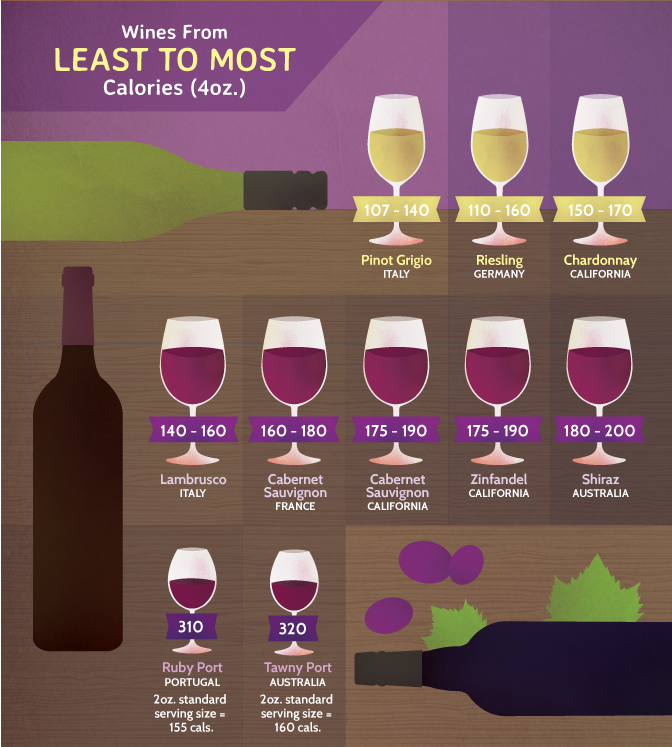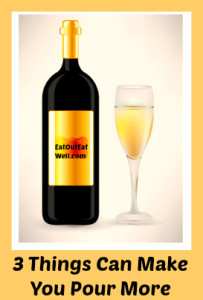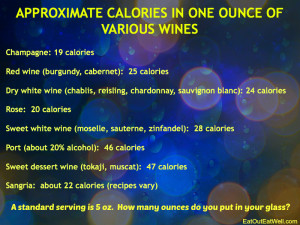Remember that alcohol can dehydrate so drink plenty of water to keep your muscles hydrated and your organs functioning normally.
Inforgraphic courtesy of Fix.com
Inforgraphic courtesy of Fix.com

Source: Fix.com
A glass or two of celebratory cheer – a toast to the New Year …
Just a heads up: all of those drinks can really pack a caloric punch. So, just like drinking wisely (and of course, not driving), don’t forget to factor in all those calories.
Do you know that a standard alcoholic drink (in the US) is a drink that contains the equivalent of 14.0 grams (0.6 ounces) of pure alcohol.
That’s the amount of pure alcohol usually found in:
A 12 ounce bottle of beer has about the same amount of alcohol as a 5 ounce glass of wine or a 1.5 ounce shot of liquor. Since it is the amount – not the type — of alcohol in your drink that affects you the most, it is not safer to drink beer or wine rather than liquor if you are drinking the same amount of alcohol.
In other words, whether you have two 5 ounce glasses of wine, two 12 ounce bottles of beer, or two 1.5 ounces of liquor either straight or in a mixed drink — you are drinking the same amount of alcohol.
Alcohol doesn’t fill you up the way food does because it doesn’t register as “food” in your GI tract or brain. Even though it doesn’t fill you up, alcohol does have calories — 7 calories a gram – more than carbs and protein, which clock in at 4 calories a gram and fat which has 9. It may not feel as though you’re putting calories into your body, but the fact is you can drink a lot of calories and still not feel stuffed (perhaps drunk, but not stuffed).
The higher the alcoholic content (proof), the greater the number of calories:
For more holiday eating and drinking tips get my ebook
available on Amazon. 
 Do you know how many ounces of wine you pour into your wine glass? Bet you don’t!
Do you know how many ounces of wine you pour into your wine glass? Bet you don’t!
A standard serving of wine is 5 ounces (around 125 calories) and probably looks smaller than you think. Wine glasses generally have a much larger capacity — good for savoring the wine, but not good for pouring portion controlled amounts.
Even though we might think we’re in control of how much we’re pouring, visual cues definitely affect how much ends up in the glass.
A new study published in Substance Use and Misuse found that people poured 11.9% more wine into a wide glass than a narrow one. They also poured 12.2% more wine into a glass when the glass was held their hands rather than when they poured into a glass sitting on a table or counter.
Color contrast made a difference, too. People poured 9.2% more white wine into a clear glass than they did red. High contrast between the wine and the glass — for instance red wine in a clear glass — makes it easier to see the level of the wine.
If you want to be careful about how much wine you’re drinking, go for taller thinner glasses rather that shorter big-bowled ones; stick to red wine – or wine that has color contrast with your glass; and when you pour, put the glass on the table rather that holding it in your hand.
 That’s not a trick question. A standard alcoholic drink (in the US) is a drink that contains the equivalent of 14.0 grams (0.6 ounces) of pure alcohol, or the amount usually found in:
That’s not a trick question. A standard alcoholic drink (in the US) is a drink that contains the equivalent of 14.0 grams (0.6 ounces) of pure alcohol, or the amount usually found in:
So, if you’re comparing a standard portion of one form of alcohol to another, there is the approximate equivalent of alcohol in each drink.
But – take note of the portion sizes. If the hand that pours puts 10 ounces of wine into a large wine glass (not unheard of) you are actually getting twice the amount of alcohol that you would get in a 12 ounce bottle of beer of a standard shot glass (1.5 ounces) of 80-proof liquor.
When you drink your calories your body doesn’t actually feel satisfied. Except for perhaps milk or other protein drinks, fluid intake doesn’t typically trigger production of the hormones that tell your brain that you’ve fed your stomach. Most liquid calories don’t produce “satiety” or the feeling of “being full,” which your brain takes as the cue to stop eating.
This is especially true if you’re slowly sipping your drink — but research has shown that even if the temporary bloat you feel after rapidly downing a beer is no substitute for satiety.
(FYI: even if you don’t feel full, the alcohol you’ve drunk still has 7 calories per gram compared to 4 calories per gram for carbohydrates and protein and 9 calories per gram for fat.)
The standard serving of wine (5 ounces) is probably visually smaller than you think. Wine glasses can generally hold a lot more, and depending on who’s pouring, can be filled with many more than 5 ounces.
Most standard servings of wine have 125-150 calories, but the calories can double depending on the size of the glass and how far it’s filled up. Sweet and dessert wines are more caloric than table wine and champagne, although the serving size is generally smaller.
For comparison, on average, a 12 ounce bottle of beer has around 153 calories and 1.5 ounces (a jigger) of 80 proof liquor has around 97 calories.
As an experiment, try filling up your usual wine glass – using water—to simulate the amount of wine you would usually pour, and then measure that amount in a measuring cup. You might be shocked to find that the serving you’re used to pouring is double the standard serving size.
You may have your preference – most of us do – but whether it’s red, white, dry, sweet, or sparkling, it is really easy to overlook the calories in those long-stemmed glasses.
If you have dessert wine after dinner it’s about double the calories per ounce although the standard serving is less: usually 2 to 3 ounces. So add on about another 100 to 150 calories for each glass of that smooth dessert wine.
Champagne: 19 calories
Red wine (burgundy, cabernet): 25 calories
Dry white wine (Chablis, reisling, chardonnay, sauvignon blanc): 24 calories
Rose: 20 calories
Sweet white wine (moselle, sauterne, zinfandel): 28 calories
Port (about 20% alcohol): 46 calories
Sweet dessert wine (tokaji, muscat): 47 calories
Sangria: about 22 calories (recipes vary)
For more tips get 30 Ways to Have Low-Calorie Fun in the Sun: Your Guide to Guilt-Free Eating at Picnics, Amusement Parks, Barbecues & Parties available from Amazon and Barnes & Noble.